Reactor Vessel Shipment Completed
— Safe From Start To Finish —
|
During the early hours of Sunday, April 27, 1997, workers at the Yankee Rowe plant prepared to open the plant gates to let the heart of the Yankee Rowe plant, the reactor pressure vessel, begin the first phase of an 1,100 mile journey through nine states that would bring the package to its final resting place in South Carolina.
The reactor vessel, which held the fuel that generated more than 33 billion kilowatt-hours of electricity over 31 years, had been removed from the plant's containment building last November. The 165 ton vessel was placed inside a 3-inch thick, 100 ton steel container certified by the NRC for transport. It was then injected with about 80 tons of concrete and the lid was welded onto the container.
The package, which weighed 365 tons including 20 tons of wire rope tie down equipment, would be the last large component removed from the plant as part of decommissioning.
The first phase of the shipment involved the transport of the package from the plant to the local rail spur at the Hoosac Tunnel in Florida, MA. Barnhart Crane & Rigging of Memphis, TN had been hired to do the job, and they were ready at 6 a.m. — as planned.
As daylight spread over the Deerfield River Valley and the media waited patiently for pictures, the 365 ton package, escorted by State Police, began the 6.5 mile trek at the Sherman Dam Bridge and then turned onto River Road.
RPV Shipment a Great Success!
Flanked by Yankee personnel, it made its way slowly — a little more than one mile per hour — into the town of Monroe where curious residents were out on the sidewalks waiting to watch it pass by. Jane Grant, Decommissioning Manager, walked ahead of the transporter handing out commemorative hats to onlookers. Mort Fairtile of the Nuclear Regulatory Commission joined Jane for part of the 6.5 mile walk, as well as Peter Fowler of Yankee, who coordinated security provisions for the shipment.
The transport continued without incident through Monroe and Florida, MA arriving at the rail spur ahead of schedule at 11:08 am. Over the next two days, employees of Barnhart Crane & Rigging, Cianbro, Bartlett Nuclear and Yankee removed the transporter tie downs and hydraulically transferred and secured the package to a rail car.
The rail car, which was leased from TransAlta Utilities Corporation of Alberta, Canada, was chosen because it was designed to transport large, heavy loads and has the ability to shift the load from side to side to clear obstacles. The package would be shipped by dedicated train, including an engine, two gondola cars, the rail car with the package, two more gondola cars and a passenger car.
|
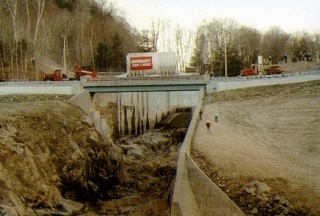
The reactor vessel package makes its way over the Sherman Dam Bridge shortly after it began its journey from the Yankee Rowe plant to the Hoosac Tunnel rail spur.
Photo by Ron Waterman
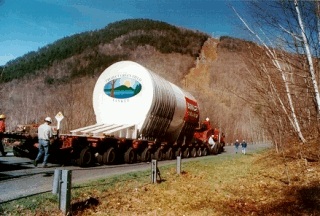
The reactor vessel package on River Road headed for the Hoosac Tunnel.
Photo by Ron Waterman
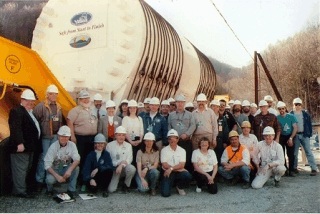
The RPV Shipment Team gathers in front of the package before it leaves the Hoosac Tunnel
Photo by Ron Waterman
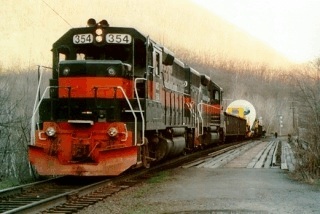
With a GTI engine ready to go, the dedicated train awaits departure from the rail spur in Florida, MA.
Photo by Ron Waterman

The dedicated train carrying the RPV package enters the Hoosac Tunnel on the first leg of its journey to SC.
Photo by Ron Waterman
|
Although it was not required to escort the shipment, Yankee decided to send specific personnel with it to demonstrate and document the process and to ensure Yankee's commitment to safety "from start to finish." In addition, the shipment had received considerable advance publicity from anti-nuclear activists and Yankee wanted to be open about the process and provide the media with access to information throughout the trip. It was also necessary for three rail car operators to be available to shift the load if there were any tight curves or obstacles
 |
|
The reactor vessel package began its 8 day journey
in Massachusetts and traveled through Vermont, New York, Pennsylvania, Maryland, Virginia, West Virginia, North Carolina and South Carolina. Here the train is traveling on the Canadian Pacific rail line heading south to Binghamton, NY.
Photo by John Parker
|
8 Days — 8 Nights — 9 States
Accompanying the shipment were Leo Lessard, manager of the reactor vessel shipment project, radiation specialists Rich Warnick and Chris Martel, Kelley Smith, media and public relations representative, Lloyd Doige, Jess Debnam and Ron Magnusson (the three rail car operators from TransAlta), and Bob and Mary Bunch. Mary provided the crew with meals and Bob maintained the passenger car. In addition, John Parker, engineer for the Yankee Rowe Project, followed the train in a car. He didn't have to worry about getting lost though because each rail company provided a security escort for their respective section of the trip. John followed the security vehicle and as a result was able to take some good photographs of the train.
At 7:40 p.m. on Tuesday, April 29, 1997, the train left the rail spur and entered the Hoosac Tunnel amid waves and cheers from all who had worked so hard to reach this milestone.
But the journey had just begun. The package would have to travel almost 1,100 miles at speeds of 10 to 25 miles per hour and be transported by five rail companies — GTI, Canadian Pacific, Conrail, Norfolk Southern and CSX. Traveling, except for the route between the Hoosac Tunnel and Mechanicville, N.Y., would be done during the day with the train held over at various train yards each evening. There would also be delays. If train traffic was heavy, the package would be pulled over to let faster trains through. The best estimate for the trip was between 5 and 10 days.
The first leg of the trip ended in the early morning hours at the Mohawk train yard just outside of Mechanicville, NY. The next day brought the train to Binghamton, NY where it was kept overnight. Thursday morning the train left for Harrisburg, PA arriving later that day and staying overnight before heading to Hagerstown, MD Friday morning. The train was kept overnight in Hagerstown, then left Saturday morning for Roanoke, VA. After an overnight stay in Roanoke, it was on to North Carolina. The train stayed in Linwood, NC Sunday night and left Monday morning for Spartanburg, SC. Tuesday brought the train from Spartanburg, SC to Columbia, SC where it spent its last evening before heading to its final destination. Yankee president, Andy Kadak, joined the train in Clinton, SC and stayed with it until it reached Barnwell.
At 5:03 p.m. on Wednesday, May 7, 1997 — after eight days on the rails — the train pulled into Barnwell, S.C.
Other than a few cows that needed to be herded away from the tracks, and less than five protesters, the trip went smoothly and without incidence. The train did receive a lot of media attention along the way, with news helicopters filming it from the air and cameramen, news photographers and reporters tracking it. They were also waiting for the train in Barnwell, SC where they reported that the Yankee Rowe package would bring $1 million to South Carolina educational funds.
Journey Ends Safely in South Carolina
Over the next several days, the package was transferred from the rail car to a road transporter. On May 13, 1997, the package was moved from the rail spur to the Chem-Nuclear Low-Level Radioactive Waste Disposal Facility and placed inside a trench where it will eventually be buried.
Although the shipment took only a few days, it took more than a year of meticulous planning and attention to detail to prepare for it. This shipment, like Yankee's more than 30 years of operation and decommissioning program, was safe from start to finish.
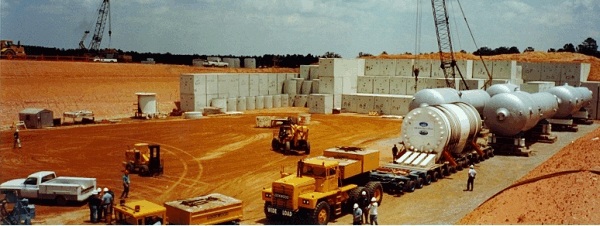
|
On May 13, 1997, the reactor vessel package was moved to Chem-Nuclear's Low-Level Waste Disposal Facility and placed inside a trench next to the Salem nuclear plant steam generators.
Photo by Ced Child
|
Home  Page
Page
 ©1996 Yankee Atomic
©1996 Yankee Atomic







 Page
Page